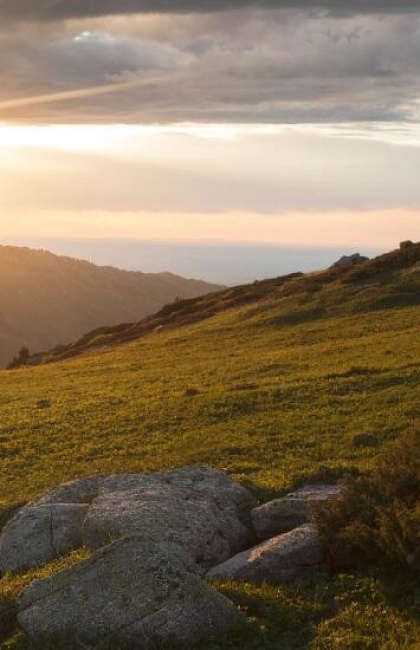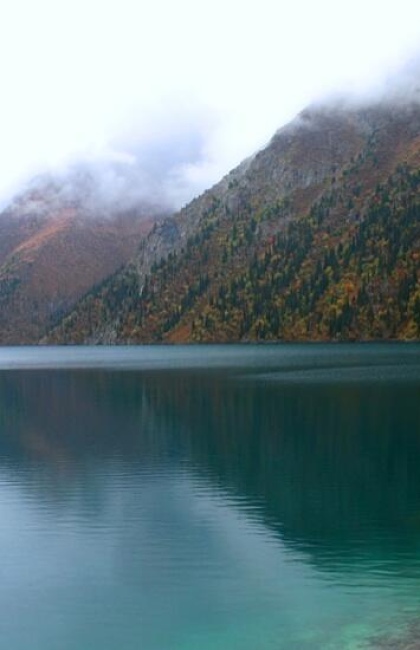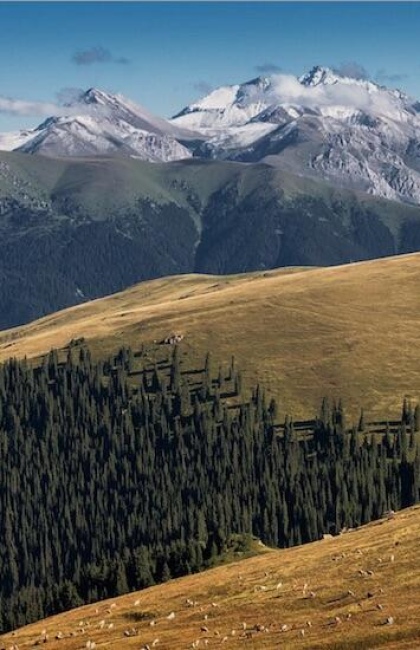A Guide to Must-Visit Attractions in the Jetysu Region
In 2022, a presidential decree established the Jetysu region, separating it from the Almaty region. The name Jetysu translates from Kazakh to "Seven rivers", which accurately describes the seven large rivers that flow through the region: Ili, Karatal, Biyen, Aksu, Lepsy, Baskan, and Sarkand. The region’s main city is Taldykorgan. There are three more cities – Tekeli, Jarkent, and Sarkand.
Jetysu is a remarkably scenic region that stretches from Lake Balkhash in the north to the Tien Shan Mountains in the south. This land is called the "golden cradle of the nation". It was here that the Kazakh Khanate was formed, marking the emergence of the Kazakh identity. The Silk Road once passed through Jetysu, leading to the development of cities, culture, science, and religion. Caravans entered the region through the Dzungarian Gates, a pass in the Dzungarian Alatau Mountains. This route was notably used by Genghis Khan in the early 13th century to conquer Central Asia. Today, the Jetysu region remains a vital trade center with neighboring China, facilitated by the Khorgos International Center for Cross-Border Cooperation.
Altyn-Emel National Park
A treasure trove of natural and historical attractions in the Jetysu region is the Altyn-Emel National Park. To the south, it is bordered by the Ili River and the Kapchagai Reservoir, and to the north, by the foothills of the Dzungarian Alatau. This reserve is home to the world's largest population of onagers and goitered gazelles. It also serves as a breeding ground for the Przewalski's horse, which has vanished from the wild. Discover more about the fascinating wildlife of Altyn-Emel in this article.
One of the park's most captivating attractions is the Singing Dune, a sand dune that produces sounds resembling an organ. There's no mysticism involved – in dry weather, the wind causes the sand grains to rub against each other, creating a melodic hum.
-large.jpeg)
The Aktau and Katutau mountains feature the most unusual landscapes in the region. Although these mountains are adjacent, they are vastly different. The white Aktau Mountains, composed of chalk and limestone, bear evidence of an ancient sea that once covered the area. Chalk and limestone are essentially the remnants of prehistoric fish bones and mollusk shells. Fossilized remains of crocodiles, mastodons, deer, and giant rhinoceroses can still be found in the Aktau Mountains. In contrast, the Katutau Mountains are a result of volcanic activity. The lava from eruptions cooled rapidly, forming rocks with unusual shapes.
Altyn-Emel is not just a desert and mountains; it also harbors real oases. One such oasis is the Kosbastau Tract, home to a grove of "dancing" turanga trees, a 700-year-old willow, and a flowing radon stream.
Altyn-Emel has numerous streams and even a waterfall. The water in these streams is often believed to have healing properties, although no scientific research has confirmed this. In a desert, water is incredibly valuable, and people often attribute almost every stream with healing properties, sometimes even considering them sacred.
Not only are the springs revered, but some trees are also considered sacred. One such tree in Altyn-Emel is known simply as Aulie Agash, which means "Sacred Tree" in Kazakh. This ancient elm tree is supposedly over 700 years old, and its massive trunk requires 5-6 people to fully embrace it.
The national park boasts several caves, the largest of which is Ungirkora, reaching a depth of 25 meters (82 ft). Scientists believe that ancient people once inhabited this cave.
Altyn-Emel is not only rich in natural beauty but also encompasses significant historical monuments. This region has been home to nomadic tribes since ancient times. Today, only necropolises remain as traces of their presence. One notable example is the Scythian burial mounds of Besshatyr, a complex of 31 mounds dating back to the early Iron Age. Excavations have uncovered swords, daggers, bows and arrows, dishes, and gold and bronze artifacts.
-large.jpeg)
Another historical monument is the Oshaktas Stelae, which consists of three tall stones arranged in a circle. Most researchers believe this structure was used for rituals and sacrifices.
At the opposite end of the national park, in the foothills of the Dzungarian Alatau, lies the Kalakai Prehistoric Monument, another stone circle. At its center stands a massive boulder adorned with petroglyphs. Some scientists suggest that Kalakai may have served as a large sundial.
Dzungarian Alatau Mountains
In the eastern part of the region, bordering the Xinjiang Uyghur Autonomous Region of China, the Dzungarian Alatau Mountains rise. Its highest point – Semenov-Tian-Shansky Peak – reaches an elevation of 4,622 meters (15164 ft).
Nestled in the Dzungarian Alatau, near the city of Tekeli, lies Kora Gorge. In the gorge, you’ll find Burkhan-Bulak, the tallest waterfall in Kazakhstan, cascading from a height of 168 meters (551 ft).
At the entrance to the gorge stands the Tekeli Stele, a pyramid-shaped stone adorned with Buddhist images and inscriptions. One image depicts a pagoda, with Buddha at its center, all supported by a lion with a dragon's head. Buddhist art and inscriptions can also be found in the nearby Terekty and Taygak gorges, close to Kora Gorge.
The Dzhungarian Alatau Mountains are home to the second largest national park in Kazakhstan – Zhongar-Alatau National Park. It was created to preserve the unique Sievers apple tree, which is believed to be the progenitor of all apple varieties on Earth.

The office of Zhongar-Alatau National Park is situated in the village of Lepsi, which holds historical significance of its own. In the 19th century, an agreement was signed here for the region's accession to the Russian Empire. This decision was made as the Kazakhs sought to safeguard their lands from Chinese claims. To them, the Russian Empire appeared to be the lesser of two evils. Additionally, Lepsi is home to a honey factory, whose products are celebrated far beyond the country’s borders.
Nestled among the mountain peaks is Lake Jasylkol, one of Kazakhstan's most picturesque lakes and a vital habitat for wapitis. The area is also home to snow leopards, Tien Shan brown bears, Pallas' cats, Turkistan lynxes, and many other species. For more information on the flora and fauna of the Dzungarian Alatau, check out our dedicated article.
Near the Kora Gorge lies the Bayan-Jurek Ridge, which may not be the tallest or most visually stunning mountains, but they boast rock paintings. These petroglyphs depict mountain goats, argali, horses, camels, and horsemen armed with bows and swords. The drawings date back to the Early Bronze Age, Iron Age, and Turkic period. Another ancient "picture gallery" is located in the Eshkiolmes Ridge, where more than 10,000 drawings were created over thousands of years by the Scythians, Wusuns, Huns, Turks, and other tribes.
The Dzungarian Alatau Mountains' foothills have been inhabited for centuries. This is evidenced not only by the petroglyphs but also by the ruins of ancient cities. One of the largest was Koilyk. Archaeologists have discovered the remains of the palace of the Karluk yabghu (rulers) here, along with its own mint. Alongside mosques, the city featured Manichaean and Buddhist temples, as well as a church.
Speaking of religious buildings, we cannot overlook the most unusual mosque in Kazakhstan – the Jarkent Mosque. Located in the town of Jarkent, the mosque resembles a Buddhist temple from Southeast Asia. It was designed by the Chinese architect Khon Pike in the 19th century. The mosque features a soaring roof with upturned ends, intricate openwork carving, and vibrant paintings.
.jpeg)
Equally interesting is the Jarkent Church – the Church of Elijah the Prophet. It’s constructed from Tien Shan spruce and richly decorated with carvings. The church was built in 1892 and survived an 8-point earthquake in 1910.
Near the ancient city of Koilyk lies the village of Cherkassk. During the Russian Civil War, the Cherkassk Defense took place here from 1918 to 1919, a conflict between newly settled Russian peasants and the Jetysu Cossacks along with Kazakh wealthy peasants. To commemorate these events, a museum and a memorial complex have been established in the village.
The village of Kapal is nestled between the Kora Gorge and the Bayan-Jurek Ridge. Founded in 1847, it was visited a year later by the famous traveler Thomas Atkinson. Kapal is also renowned as the birthplace of Sara Tastanbekkyzy, a female akyn (poet) and master of aitys (improvised singing). A memorial museum dedicated to her can be found in the village. Near Kapal is the village of Arasan, home to the oldest balneological resort in Kazakhstan, Kapal-Arasan. It has been in operation since 1886.
Amazing lakes
The main attraction for beachgoers in the Jetysu region is the southwestern shore of Lake Alakol. The lake's water is reputed to have healing properties, thanks to the unique black beaches made of shungite pebbles. Shungite enriches the water with minerals such as nitrogen, fluorine, bromine, and iron. The southwestern shore is lined with various guest houses and resorts, primarily located in the villages of Koktuma and Akshi. You can find a list of 10 popular recreation centers with contact information here.
In addition to Lake Alakol, there are three more lakes in the area: Jalanashkol, Sasykkol, and Koshkarkol. Together, they form the Alakol lake system. In 1998, the Alakol Nature Reserve was established to protect this area. The reserve includes nesting sites for various waterfowl birds, such as curly and pink pelicans, relict gulls, bitterns, cormorants, and spoonbills. Each year, the Wings of Alakol birdwatching festival is held on the lake's shore.
-large.jpeg)
The eastern end of Lake Balkhash also falls within the Jetysu region. However, unlike the northern shore in the Karaganda region, beach recreation is not developed here. The southeastern shore of Balkhash is a harsh area, with the Saryesik-Atyrau desert extending there.
It is impossible to list all the unique places of the Jetysu region in one article. There are numerous ancient settlements, majestic mountain peaks, and scenic gorges yet to be explored. Amazing discoveries await travelers at every turn. We hope to have inspired you to visit this picturesque region.

_420x650_4ab.jpg)
_420x650_4ab.jpg)

_420x650_4ab.jpg)

_420x650_4ab.jpg)
_420x650_4ab.jpg)
_420x650_4ab.jpg)
